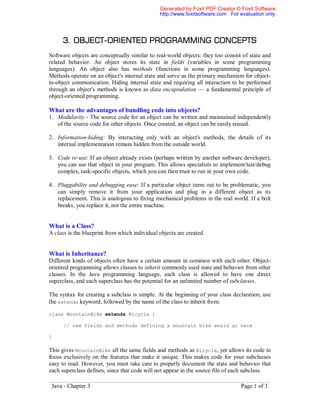
Java chapter 3 - OOPs concepts
- 1. Generated by Foxit PDF Creator © Foxit Software http://www.foxitsoftware.com For evaluation only. 3. OBJECT-ORIENTED PROGRAMMING CONCEPTS Software objects are conceptually similar to real-world objects: they too consist of state and related behavior. An object stores its state in fields (variables in some programming languages). An object also has methods (functions in some programming languages). Methods operate on an object's internal state and serve as the primary mechanism for objectto-object communication. Hiding internal state and requiring all interaction to be performed through an object's methods is known as data encapsulation — a fundamental principle of object-oriented programming. What are the advantages of bundling code into objects? 1. Modularity:- The source code for an object can be written and maintained independently of the source code for other objects. Once created, an object can be easily reused. 2. Information-hiding: By interacting only with an object's methods, the details of its internal implementation remain hidden from the outside world. 3. Code re-use: If an object already exists (perhaps written by another software developer), you can use that object in your program. This allows specialists to implement/test/debug complex, task-specific objects, which you can then trust to run in your own code. 4. Pluggability and debugging ease: If a particular object turns out to be problematic, you can simply remove it from your application and plug in a different object as its replacement. This is analogous to fixing mechanical problems in the real world. If a bolt breaks, you replace it, not the entire machine. What is a Class? A class is the blueprint from which individual objects are created. What is Inheritance? Different kinds of objects often have a certain amount in common with each other. Objectoriented programming allows classes to inherit commonly used state and behavior from other classes. In the Java programming language, each class is allowed to have one direct superclass, and each superclass has the potential for an unlimited number of subclasses. The syntax for creating a subclass is simple. At the beginning of your class declaration, use the extends keyword, followed by the name of the class to inherit from: class MountainBike extends Bicycle { // new fields and methods defining a mountain bike would go here } This gives MountainBike all the same fields and methods as Bicycle, yet allows its code to focus exclusively on the features that make it unique. This makes code for your subclasses easy to read. However, you must take care to properly document the state and behavior that each superclass defines, since that code will not appear in the source file of each subclass. Java - Chapter 3 Page 1 of 3
- 2. Generated by Foxit PDF Creator © Foxit Software http://www.foxitsoftware.com For evaluation only. The Java Programming Language As you've already learned, objects define their interaction with the outside world through the methods that they expose. Methods form the object's interface with the outside world; the buttons on the front of your television set, for example, are the interface between you and the electrical wiring on the other side of its plastic casing. You press the "power" button to turn the television on and off. In its most common form, an interface is a group of related methods with empty bodies. What Is a Package? A package is a namespace that organizes a set of related classes and interfaces. Conceptually you can think of packages as being similar to different folders on your computer. You might keep HTML pages in one folder, images in another, and scripts or applications in yet another. Because software written in the Java programming language can be composed of hundreds or thousands of individual classes, it makes sense to keep things organized by placing related classes and interfaces into packages. The Java platform provides an enormous class library (a set of packages) suitable for use in your own applications. This library is known as the "Application Programming Interface", or "API" for short. Its packages represent the tasks most commonly associated with generalpurpose programming. For example, a String object contains state and behavior for character strings; a File object allows a programmer to easily create, delete, inspect, compare, or modify a file on the filesystem; a Socket object allows for the creation and use of network sockets; various GUI objects control buttons and checkboxes and anything else related to graphical user interfaces. There are literally thousands of classes to choose from. This allows you, the programmer, to focus on the design of your particular application, rather than the infrastructure required to make it work. Questions and Exercises: Questions 1. 2. 3. 4. 5. 6. 7. 8. 9. Real-world objects contain ___ and ___. A software object's state is stored in ___. A software object's behavior is exposed through ___. Hiding internal data from the outside world, and accessing it only through publicly exposed methods is known as data ___. A blueprint for a software object is called a ___. Common behavior can be defined in a ___ and inherited into a ___ using the ___ keyword. A collection of methods with no implementation is called an ___. A namespace that organizes classes and interfaces by functionality is called a ___. The term API stands for ___ Answers to Questions 1. state and behavior. 2. fields. 3. methods. Page 2 of 3 Java - Chapter 3
- 3. Generated by Foxit PDF Creator © Foxit Software http://www.foxitsoftware.com For evaluation only. The Java Programming Language 4. 5. 6. 7. 8. 9. encapsulation. class. superclass, subclass, extends. interface. package. Application Programming Interface. Prof. Mukesh N Tekwani [mukeshnt@yahoo.com] Page 3 of 3